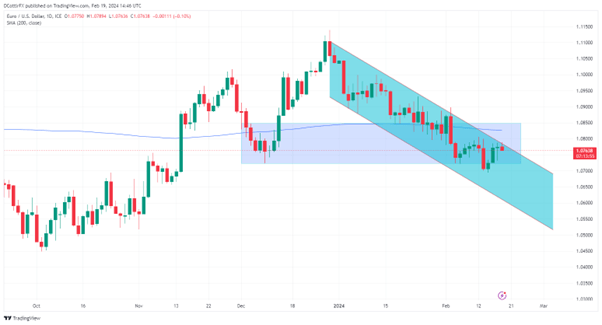EUR/USD Analysis and Charts
- EUR/USD inched lower in the European session.
- The overall downtrend in place all year remains dominant.
- Germany’s PMI data later this week could bring some movement.
Learn how to trade EUR/USD with our complimentary guide



The Euro lost a little ground against the United States Dollar on Monday but, as the latter’s home market is going to be largely shut down for the Presidents’ Day break, the real trading action will probably come later in the week when the data releases start to trickle out.
The first big one will be on the Dollar side, with the release of minutes from the Federal Reserve’s last monetary policy meeting due on Wednesday. These might now look even more historic than usual given that robust economic numbers out of the US since the meeting have seen rate-cut expectations pushed out to June, but the nuances of Fed discussion usually manage to move markets, if not always durably.
The Euro may struggle a bit on Thursday if the closely watched February Purchasing Managers Index snapshot out of Germany can’t beat gloomy expectations. The manufacturing sector is expected to have continued to contact, if at a slower pace than in the previous month. A reading of 46.1 is expected, after January’s 45.5. Anything below 50 signifies a contraction for the sector, and this gauge has been below that since early 2022.
As-expected figures will hardly suggest that the German economy needs the current, record-high interest rates it’s stuck with, but the European Central Bank will want to be sure that inflation has been stopped before it offers any relief there and rate cuts aren’t expected to come anytime soon. Indeed, some economists think we could be well into next year before inflation returns to its 2% target.
The Euro has been weakening against its US rival all year and there seems little on this week’s schedule likely to halt that process.
EUR/USD Technical Analysis

EUR/USD Daily Chart Compiled Using TradingView
The downtrend channel from December 28’s closing high has been remarkably well respected since, with its current top of 1.07853 now likely to see rejection.
The slide since late January has also seen the back in a broad trading range last seen in early December, between 1.08495 and 1.07247. The single currency did nudge below the range base last week, but it wasn’t there for long and it traded back into the band very quickly, suggesting that Euro bulls are prepared to show some resolve at those levels.
Keep an eye on the 200-day moving average for this pair now. It slipped below the line on February 2 and hasn’t been able to get back to it since. The average is now some way above the market at 1.08625.
IG’s sentiment data finds traders balanced finely between bullishness and bearishness over EUR/USD, perhaps suggesting that this is a market in need of a new catalyst.
See how IG Retail Sentiment can help you make a more informed decision.
| Change in | Longs | Shorts | OI |
| Daily | 15% | -6% | 3% |
| Weekly | -14% | 20% | 0% |
--By David Cottle for DailyFX





